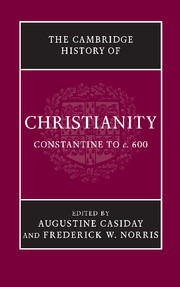Book contents
- Frontmatter
- Introduction
- Part I Christianity: Regional Developments
- Part II Christianity Contested
- Part III Christian Culture and Society
- Part IV Christian Beliefs and Practices
- 18 Discourse on the Trinity
- 19 History of Christology to the seventh century
- 20 Sin and salvation: Experiences and reflections
- 21 From Antioch to Arles: Lay devotion in context
- 22 Saints and holy men
- 23 Pastoral care and discipline
- 24 Sexuality, marriage and the family
- 25 The growth of liturgy and the church year
- 26 Interpreting scripture
- 27 Asceticism and monasticism, I: Eastern
- 28 Asceticism and monasticism, II: Western
- 29 Art and Propaganda fide: Christian art and architecture, 300–600
- Index
- Map 1 The Roman empire, c. 400">
- References
29 - Art and Propaganda fide: Christian art and architecture, 300–600
from Part IV - Christian Beliefs and Practices
Published online by Cambridge University Press: 28 March 2008
- Frontmatter
- Introduction
- Part I Christianity: Regional Developments
- Part II Christianity Contested
- Part III Christian Culture and Society
- Part IV Christian Beliefs and Practices
- 18 Discourse on the Trinity
- 19 History of Christology to the seventh century
- 20 Sin and salvation: Experiences and reflections
- 21 From Antioch to Arles: Lay devotion in context
- 22 Saints and holy men
- 23 Pastoral care and discipline
- 24 Sexuality, marriage and the family
- 25 The growth of liturgy and the church year
- 26 Interpreting scripture
- 27 Asceticism and monasticism, I: Eastern
- 28 Asceticism and monasticism, II: Western
- 29 Art and Propaganda fide: Christian art and architecture, 300–600
- Index
- Map 1 The Roman empire, c. 400">
- References
Summary
Introduction: Art and the Church
Since Jesus declared poverty and humility to be the most important Christian virtues, the question inevitably arises as to why the church accepted architectural ornamentation and the public display of artistic pomp. Although the Church as institution never formally pronounced on this matter (e.g., at a council), it has traditionally used art and architecture to project a specific image and as an advertisement for itself. The first section of this essay discusses in a broader context the issue of the acceptance of the pictorial religious image in Christianity.
The cardinal rule of advertising is that it must offer its target audience benefits, or at least define benchmarks that are achievable for the consumer under the right circumstances. This then leads to the question as to which artistic media the church has used to instil faith in would-be converts. Hence, the second section discusses baptism and baptisteries, and poses the following question: Once a person had accepted Christ and been baptised, what impact did the church have on the believer through the medium of art and architecture?
The third section explores the following questions: How does the Church present its content? or, in modern parlance: How does the church market salvation to believers through the medium of art? If we wish to understand how art and architecture serve the interests of theology, the preaching of the Christian message, brotherly love, works of charity, the celebration of mass, and the cult of saints, we must turn not to texts but to actual works of ecclesiastical art and architecture.
Keywords
- Type
- Chapter
- Information
- The Cambridge History of Christianity , pp. 691 - 725Publisher: Cambridge University PressPrint publication year: 2007
References
- 2
- Cited by

